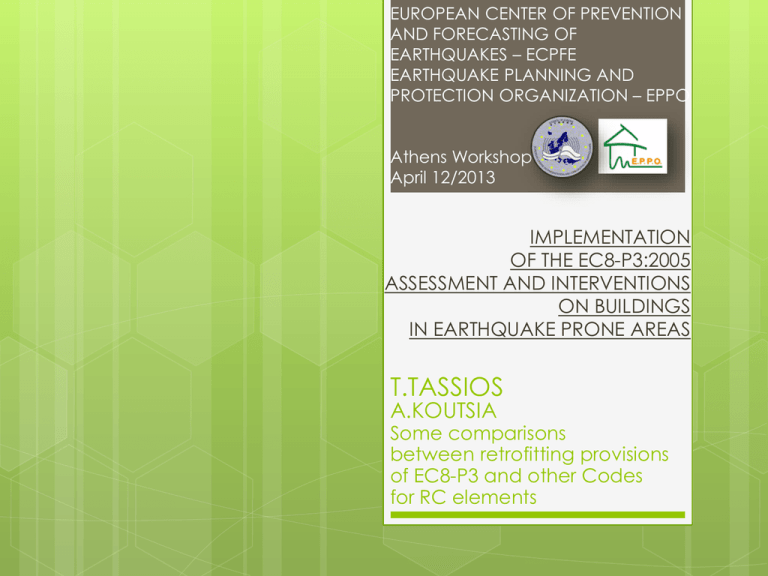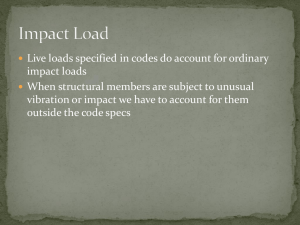EC8-P3
advertisement

EUROPEAN CENTER OF PREVENTION AND FORECASTING OF EARTHQUAKES – ECPFE EARTHQUAKE PLANNING AND PROTECTION ORGANIZATION – EPPO Athens Workshop April 12/2013 IMPLEMENTATION OF THE EC8-P3:2005 ASSESSMENT AND INTERVENTIONS ON BUILDINGS IN EARTHQUAKE PRONE AREAS T.TASSIOS A.KOUTSIA Some comparisons between retrofitting provisions of EC8-P3 and other Codes for RC elements Table of Contents 2 1. Scope………………………………………………… 3 2. Strengthening against shear………………. 5 2.1 FRP jacketing………………………………………. 5 i. EC8-P3……………………………………………….. 5 α. Design formulae…………………………………… 5 b. Notation……………………………………………..6 ii. KANEPE……………………………………..…….. 7 Design formulae………………………………….7 2.1.1 Numerical example…………………………… 8 2.1.2 Conclusion…………………………………………… 10 2.2 Steel jacketing…………………………………….. 11 i. EC8-P3………………………………………………….. 11 α. Design formulae…………………………………….. 11 b. Notation……………………………………………….. 11 ii. KANEPE/TH.P.T………………………………………. 12 Design formulae…………………………………….. 12 2.2.1 Numerical example……………………………13 2.2.2 Conclusion…………………………………………… 15 3. Confinement versus local ductility……. 16 3.1 FRP jacketing……………………………………… 16 i. EC8-P3………………………………………………..16 α. Design formulae…………………………………….. 16 b. Notation……………………………………………..16 ii. KANEPE……………………………………………. 17 Design formulae…………………………………17 3.1.1 Numerical example……………………………18 3.1.2 Conclusion……………………………………………20 3.2 Steel jacketing………………………………… 21 i. EC8-P3……………………………………………….. 21 ii. EC8-P1……………………………………………….. 22 α. Design formulae…………………………………….. 22 b. Notation…………………………………………….. 22 iii. KANEPE…………………………………………….. 23 Design formulae…………………………………..23 3.2.1 Numerical example…………………………… 24 3.2.2 Conclusion……………………………………………26 4. Clamping of lap-splices……………………………………… 27 4.1 FRP jacketing……………………………………… 27 i. EC8-P3……………………………………………….. 27 α. Design formulae……………………………………27 b. Notation…………………………………………….. 27 ii. KANEPE……………………………………………. 29 Design formulae……………………………………29 4.1.1 Numerical example…………………………… 30 4.1.2 Conclusion……………………………………………32 4.2 Steel jacketing…………………………………….. 33 i. EC8-P3……………………………………………….. 33 ii. KANEPE……………………………………………. 34 Design formulae……………………………………34 4.2.1 Numerical example…………………………… 35 4.2.2 Conclusion……………………………………………37 1. Scope (a) 3 EC8-P3 will need, as all Codes do, to be improved and modified on a regular basis, : the ongoing work, the feedback from Code-users and continuing developments in “repair technology”; as well as : possible mistakes and internal inconsistencies. 1. Scope (b) 4 This study attempts to make some comparisons between retrofitting provisions of EC8-P3 and KANEPE (GCSI) for RC elements; : Strengthening against shear, Confinement action versus local ductility and Clamping of lap-splices. 2. Strengthening against shear 2.1 FRP jacketing NOTE: γfd=1,5 is the partial factor for FRP debonding For fully wrapped (i.e. closed) or properly anchored (in the compression zone) jackets: 5 i. EC8-P3 a. Design formulae 2. Strengthening against shear 2.1 FRP jacketing θ: β: 6 i. EC8-P3 b. Notation strut inclination angle, angle between the (strong) fibre direction in the FRP sheet and the axis of the member, wf: width of the FRP sheet measured orthogonally to the (strong) direction of the fibres (for sheets: wf=min(0,9d,hw)sin(θ+β)/sinθ), sf: spacing of FRP sheet measured orthogonally to the (strong) fibre direction (=wf), Le: effective bond length, z =0,9d; internal lever arm, ffdd: design debonding strength, ffu,W(R): ultimate strength of the FRP sheet wrapped around the corner with a radius R and fdd,e,W: design FRP effective debonding strength 2. Strengthening against shear 2.1 FRP jacketing ii. KANEPE 7 Design formulae NOTE: γRd=1,5 For beams: For columns: U-shaped (i.e., open) jackets Fully wrapped (i.e., closed) or properly anchored (in the compression zone) jackets 2. Strengthening against shear 2.1 FRP jacketing 8 2.1.1 Numerical example (a) Column: b=250 mm Concrete: fc=19 MPa, c=20 mm Reinforcement: S400, 4Φ20, Φ6/250 FRP: ffu=2900 MPa, Ef=260000 MPa, tl=0,12 mm Additional shear load: ΔV=70 kN NOTE: the partial factor of the FRP is taken equal to 1,1 EC8-P3 KANEPE for θ=π/4 in favor of safety σj0=1757,58 MPa and β=π/2, z0=176 mm 4 layers of FRP with Σtf=0,48 mm tj,req=0,23 mm account for: 2 layers of FRP with Σtj=0,24 mm are ffdd =467,88 MPa required <ηRffu-ffdd>=903,03 MPa>0 ffu,w=1370,91 MPa τmax=2,73 MPa ffdde,w=392,70 MPa VRd,f=74,64 kN 2. Strengthening against shear 2.1 FRP jacketing 9 2.1.1 Numerical example (b) Column: b=250 mm Concrete: fc=19 MPa, c=20 mm Reinforcement: S400, 4Φ20, Φ6/250 FRP: ffu=2900 MPa, Ef=260000 MPa, tl=0,12 mm (VRd,f=74,64 kN) 2. Strengthening against shear 2.1 FRP jacketing The 10 2.1.2 Conclusion two documents lead in average to the same values of required FRP thickness. However, we confess that we were unable to understand why, following EC8-P3 A.4.4.2 (5), such a simple strengthening, in such a small column, fails by debonding in spite of the Fully wrapped (i.e., closed) equilibrium offered near the or properly anchored (in the compression zone) jackets curved corner (forces Fc). 2. Strengthening against shear 2.2 Steel jacketing b. Notation θ: β: b: s: as previously stated, as previously stated, width of the steel straps and spacing of the steel straps Evidently b/s=1 in case of continuous steel plates. 11 i. EC8-P3 a. Design formulae 2. Strengthening against shear 2.2 Steel jacketing ii. KANEPE/TH.P.T. 12 Design formulae NOTE: γRd=1,5 For beams: For columns: U-shaped (i.e., open) jackets Fully wrapped (i.e., closed) or properly anchored (in the compression zone) jackets 2. Strengthening against shear 2.2 Steel jacketing 13 2.2.1 Numerical example (a) Column: b=250 mm Concrete: fc=19 MPa, c=20 mm Reinforcement: S400, 4Φ20, Φ6/250 Steel plate: f 'sy=275 MPa Additional shear load: ΔV=70 kN NOTE: the partial factor of the steel plate is taken equal to 1,15 EC8-P3 KANEPE for θ=π/4 in favor of safety σj0=159,42 Mpa and β=π/2, z0=176 mm tj,req=1,17 mm tj,req=2,50 mm 2. Strengthening against shear 2.2 Steel jacketing 14 2.2.1 Numerical example (b) Column: b=250 mm Concrete: fc=19 MPa, c=20 mm Reinforcement: S400, 4Φ20, Φ6/250 Steel plate: f 'sy=275 MPa 2. Strengthening against shear 2.2 Steel jacketing 15 2.2.2 Conclusion EC8-P3 leads to much lower values of required steelplate thickness because: it it considers zo~h and does not leave stress-margins (~ 30%) for possible local overstress along the diagonal crack. 3. Confinement action versus local ductility 3.1 FRP jacketing 16 i. EC8-P3 a. Design formulae b. Notation bw: larger section width, εcu =0,0035, εju =ffu/Ef; adopted FRP jacket ultimate strain, lower than the ultimate strain εfu=0,015 for CFRP and f’1: confinement pressure f1 applied by the FRP sheet after its corners have been rounded to allow wrapping around them Effectively confined area in an FRPwrapped section 3. Confinement action versus local ductility 3.1 FRP jacketing 17 ii. KANEPE Design formulae NOTE: If the number of required FRP layers k is higher than 3, the effectiveness of the additional FRP layers is reduced; 3. Confinement action versus local ductility 3.1 FRP jacketing 18 3.1.1 Numerical example (a) Column: b=250 mm, μφ,av=1,00 Concrete: fc=19 MPa, c=20 mm Reinforcement: S400, 4Φ20, Φ6/250 FRP: ffu=2900 MPa, Ef=260000 MPa Additional axial load: N=800 kN In order to achieve μφ,tar=9,00: NOTE: the partial factor of the FRP is taken equal to 1,1 EC8-P3 KANEPE Ix=9,000 fjd=2636,36 MPa εju=0,0112 v=0,674 f’1=6,40 MPa εsy=0,0020 ks=0,400 ano=0,333 f1=16,00 MPa an=0,733 tf,req=0,69 mm tj,req=0,81 mm for k=7>3, ψ=0,615 f’jd=ψfjd=1620,81 MPa t’j,req=1,32 mm 3. Confinement action versus local ductility 3.1 FRP jacketing 19 3.1.1 Numerical example (b) Column: b=250 mm, μφ,av=1,00 Concrete: fc=19 MPa, c=20 mm Reinforcement: S400, 4Φ20, Φ6/250 FRP: ffu=2900 MPa, Ef=260000 MPa Additional axial load: N=800 kN 3. Confinement action versus local ductility 3.1 FRP jacketing 20 3.1.2 Conclusion A question may be raised here about the first approach of EC8-P3 (A.34) on confinement action versus local ductility; the cross sectional effectiveness factor a is not included in the design formulae – as opposed to the second EC8-P3 approach A.4.4.3 (6) - which was examined by Prof. Dritsos in the previous presentation - and KANEPE provisions. It is also noted that EC8-P3, as opposed to KANEPE provisions, does not consider the reduced effectiveness of additional FRP layers after a certain number (say 5). As a result, it is rather a numerical coincidence that the values of required FRP thickness for this first approach (A.34) are quite similar in the case of EC8-P3 and KANEPE provisions for targeted local ductility values around 10,00 – as opposed for the case of lower (<9) and higher (>11) μ1/r -values when EC8-P3 values become disproportionally low and high respectively. 3. Confinement action versus local ductility 3.2 Steel jacketing 21 i. EC8-P3 3. Confinement action versus local ductility 3.2 Steel jacketing 22 ii. EC8-P1 a. Design formulae b. Notation bc: bo: gross cross-sectional width and width of confined core Evidently bc/bo=1 in case of continuous steel plates. NOTE: According to Table 5.1 and assuming au/a1=1,0, qo,DCM=3,0 and qo,DCH=4,5. Furthermore, assuming Tc=2T1 in accordance with Equation 5.5 μφ=1+2(qo-1)Tc/T1, μφ,DCM=9 and μφ,DCH=15. 3. Confinement action versus local ductility 3.2 Steel jacketing 23 iii. KANEPE Design formulae 3. Confinement action versus local ductility 3.2 Steel jacketing 24 3.2.1 Numerical example (a) Column: b=250 mm, μφ,av=1,00 Concrete: fc=19 MPa, c=20 mm Reinforcement: S400, 4Φ20, Φ6/250 Steel plate: f 'sy=275 MPa Additional design axial load: Nd=800 kN In order to achieve μφ,tar=9,00: NOTE: the partial factor of the steel plate is taken equal to 1,15, while the reduced partial factors of concrete and reinforcing steel are taken equal to 1,3 and 1,05 respectively EC8-P1 KANEPE vd=0,876 εsyd=0,0019 an=0,333 as=1,000 a=0,333 ωwd,min=1,246 tj,req=3,38 mm tj,req=4,76 mm 3. Confinement action versus local ductility 3.2 Steel jacketing 25 3.2.1 Numerical example (b) Column: b=250 mm, μφ,av=1,00 Concrete: fc=19 MPa, c=20 mm Reinforcement: S400, 4Φ20, Φ6/250 Steel plate: f 'sy=275 MPa Additional design axial load: Nd=800 kN 3. Confinement action versus local ductility 3.2 Steel jacketing EC8-P3 3.2.2 Conclusion 26 does not offer any quantitative guidance regarding the use of external steel confinement in the form of steel jacketing as a strengthening method for increasing the local ductility of a member. Following EC8-P1 on this subject, however, with the appropriate modifications regarding the partial factors of existing materials, the values of required steel-plate thickness are relatively high for higher targeted local ductility values compared to the values resulting from KANEPE provisions. 4. Clamping of lapsplices 4.1 FRP jacketing 27 a. Design formulae b. Notation i. EC8-P3 (a) bw: as previously stated, p: perimeter line in the column cross-section along the inside of longitudinal steel, n: number of spliced bars along p, fyL =fy/CFKL3; yield strength of longitudinal steel reinforcement; σ1: clamping stress over the lapsplice length Ls and σ’1: active pressure from the grouting between the FRP and the column at a strain of 0,001 NOTE: CFKL3 = 1,00 is the confidence factor for full knowledge i. EC8-P3 (b) 4. Clamping of lap“For members of rectangular section with splices longitudinal bars lapped over a length Ls starting the end section of the member, an 4.1 FRP jacketing from alternative to the previous for the calculation of 28 the effect of FRP wrapping over a length exceeding by no less than 25% the length of the lapping, is:” 4. Clamping of lapsplices 4.1 FRP jacketing 29 ii. KANEPE Design formulae 4. Clamping of lapsplices 4.1 FRP jacketing 30 4.1.1 Numerical example (a) Column: b=250 mm Concrete: fc=19 MPa, c=20 mm Reinforcement: S400, 4Φ20, Φ6/250 FRP: ffu=2900 MPa, Ef=260000 MPa Assuming ls/db=25: NOTE: the partial factor of the FRP is taken equal to 1,1 EC8-P3 (a) KANEPE σ1=1,52 MPa su=2,0 mm ks=0,4 sd=0,4 mm σ’1=0,61 MPa wd=0,33 mm tf,req=0,29 mm tj,req=0,36 mm EC8-P3 (b) a=al,f=0,760 ρf=0,0022 ff,e=2081,21 Mpa tf,req=0,27 mm 4. Clamping of lapsplices 4.1 FRP jacketing 31 4.1.1 Numerical example (b) Column: b=250 mm Concrete: fc=19 MPa, c=20 mm Reinforcement: S400, 4Φ20, Φ6/250 FRP: ffu=2900 MPa, Ef=260000 MPa 4. Clamping of lapsplices 4.1 FRP jacketing Several 4.1.2 Conclusion 32 opinions exist about the meaning of the symbol εf,u being used in the alternative second approach A.4.4.4 (3) of EC8-P3 regarding the clamping of lap-splices along with FRP jacketing. Our application is literally in accordance with the provisions of the text of the Code putting εf,u equal to the actual ultimate elongation of the FRP that however should not be taken higher than 0,015. On the other hand, if εf,u were the real strain of the FRP under the given conditions, the resulting values of required FRP thickness would then be approximately 100% higher than the previous ones. 4. Clamping of lapsplices 4.2 Steel jacketing 33 i. EC8-P3 4. Clamping of lapsplices 4.2 Steel jacketing 34 ii. KANEPE Design formulae 4. Clamping of lapsplices 4.2 Steel jacketing 35 4.2.1 Numerical example (a) Column: b=250 mm Concrete: fc=19 MPa, c=20 mm Reinforcement: S400, 4Φ20, Φ6/250 Steel plate: f 'sy=275 Mpa Assuming ls/db=25: NOTE: the partial factor of the steel plate is taken equal to 1,15 KANEPE su=2,0 mm sd=0,4 mm (AB)=99 mm provided that: wy=0,13 mm<wd=0,33 mm tj,req=2,32 mm 4. Clamping of lapsplices 4.2 Steel jacketing 36 4.2.1 Numerical example (b) Column: b=250 mm Concrete: fc=19 MPa, c=20 mm Reinforcement: S400, 4Φ20, Φ6/250 Steel plate: f 'sy=275 Mpa 4. Clamping of lapsplices 4.2 Steel jacketing 4.2.2 Conclusion 37 It is hoped that in the near future EC8-P3 will also offer regarding the use of external steel confinement in the form of steel jacketing as a strengthening method of inadequate splices. Thank you!







